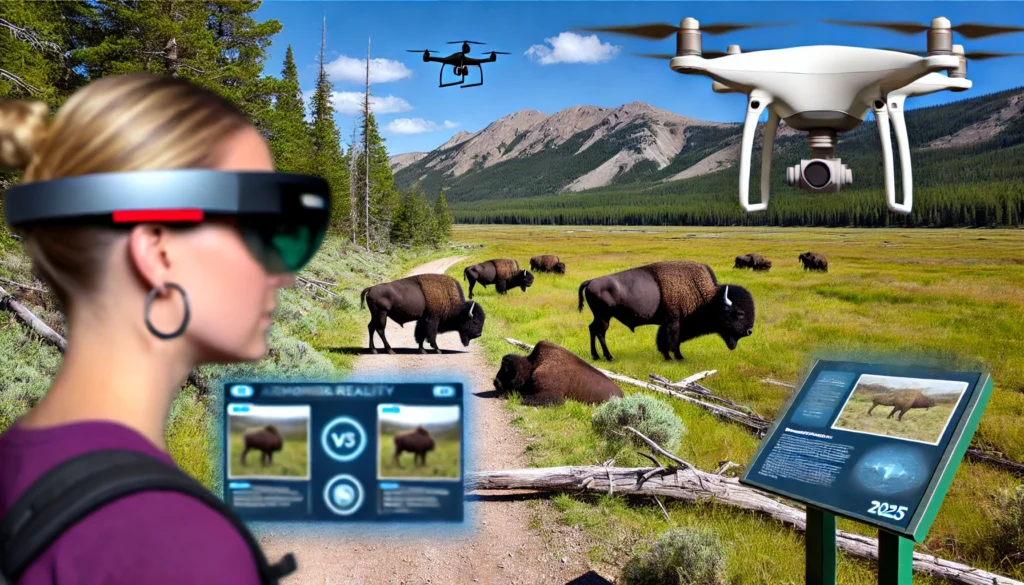In the world of breathtaking landscapes and vast wilderness, the U.S. National Parks have always been a sacred haven for wanderers, wildlife lovers, and anyone in need of a break from the concrete jungle. But as we navigate through 2025, something curious is happening: national parks are evolving. Not in the typical “new trail” kind of way, but more like a combination of futuristic ingenuity and Mother Nature’s charm. It’s as if Elon Musk and a wise old park ranger decided to join forces—a scenario that sounds ridiculous, but, oh, what a sight it’d be!
Rewilding with a Tech Twist
Picture Yellowstone with its iconic geysers. Now add a dash of technology that would make even the most jaded millennial glance up from their phones. Parks across the U.S. are incorporating smart technology—from AI-powered animal monitoring systems to interactive augmented reality (AR) guides. Forget the old foldable maps (the ones that never fold back the right way). Instead, visitors in 2025 are greeted by augmented reality glasses that display all sorts of useful information: where to spot a herd of bison, which hot spring is best avoided if you value not being scalded, and which trail leads to that jaw-dropping Instagram-worthy view.
Even the flora is getting a spotlight. Smart sensors now monitor the health of endangered plants in real-time, and you can even receive notifications on your phone about a rare bloom nearby. It’s like Tinder, but instead of people, you’re swiping on plant sightings—it’s eco-romance at its finest. Keywords like “National Park tech upgrades” and “Yellowstone 2025 AR guide” are now trending because, who wouldn’t want to see a geyser explode with some AR-enhanced magic?
Wildlife, Unbothered
National parks have always been synonymous with wildlife—but the future brings an upgraded co-existence. Picture Yosemite—a beautiful deer munching lazily by the trail—and think about how much less hassle it is now, thanks to the revolutionary “Wildlife No-Go Zones.” Gone are the days of warning visitors with signs and leaflets. In 2025, park officials are utilizing virtual fences and real-time updates to keep people safely distant from wildlife habitats, all while not disturbing the animals. These virtual zones can adapt as seasons change or when Mrs. Bear decides it’s a good time to wander closer to the visitor center.
Plus, the ever-expanding use of drones—drones that work for good this time, mind you. These nifty gadgets are being used not to film viral dance videos but to safely monitor wildlife populations, study migration patterns, and even assist in wildlife rescues. “Sustainable park initiatives,” “wildlife conservation drones,” and “Yosemite no-go zones” are just a few of those keywords making waves in search engines.
The New Frontier: Accessibility for All
Another surprising way national parks are evolving is how they’re becoming accessible to everyone. No, really—everyone. The elderly, people with disabilities, young families, and even those of us who think a “hike” is a euphemism for a casual stroll to Starbucks. Gone are the steep trails that were more akin to an extreme sport than a pleasant walk. In 2025, national parks are making inclusion their mission. Wheelchair-friendly trails are now accompanied by self-driving electric shuttles to help you navigate through the park’s less accessible areas—because, honestly, who said you need to break a sweat to enjoy nature?
And here’s a quirky twist—guided meditation and soundscape stations have made their debut. Feel like you’re walking through the Redwoods while listening to curated whale songs and motivational tidbits from your favorite celebrity. Imagine Oprah telling you “you can do it” while a gentle breeze rustles the leaves overhead. The blending of technology with the natural setting might sound unconventional, but if it brings more people to understand and appreciate these beautiful spaces, then it’s a win.
Combatting Climate Change with Creativity
Ah, climate change—the ominous cloud hanging over the beauty of the national parks. But in 2025, park officials have gone beyond just trying to “protect” these lands. They’re actively combating climate change with all the creativity of an over-caffeinated environmentalist. Think solar-powered visitor centers, electric vehicle-only parking lots, and restoration programs that could make a botanist weep with joy. Keywords like “carbon-neutral parks” and “climate initiatives in national parks” are becoming central to every nature lover’s vocabulary.
There’s even a return to traditional methods—prescribed fires have become the MVPs of forest management, effectively reducing the risk of catastrophic wildfires. It’s a gamble, sure, but one that involves the ultimate high-stakes game of Jenga with nature. When done right, it works wonders for the ecosystem, providing a renewed habitat for native species and, somewhat paradoxically, keeping fire hazards at bay.
Tourism Takes a Wild Turn
Oh, and let’s not forget the visitors. The way we “tourist” is getting its own rebranding. With the influx of technology and environmental consciousness, parks are finding new ways to engage even the least outdoorsy of folks. Ever been to a “glamping” spot at a national park? Well, in 2025, luxury yurts, eco-pods, and solar-powered tents are becoming the norm—with all the modern amenities, of course. Because who wouldn’t want WiFi and heated floors right in the middle of the Rockies? Search terms like “luxury camping in U.S. parks” and “eco-friendly glamping spots” are steadily on the rise.
If you’re planning on going off the beaten path, there’s now an app for that—quite literally. Smart apps suggest the less popular but equally stunning trails for a more secluded experience, designed specifically for those moments when you’d rather not see anyone for an entire day. Solitude is the new luxury, after all. And yes, there’s a keyword for that too: “solitude hiking trails.”
Concluding Thoughts
As 2025 rolls on, U.S. National Parks are reshaping themselves to meet the needs of a changing world—one that values accessibility, innovation, and nature’s preservation more than ever before. So pack your AR glasses, get ready for some unexpected techie-meets-nature vibes, and maybe, just maybe, swap your old foldable map for a drone-guided journey. To read more about these innovative changes, you can check out the National Park Service’s latest updates here.
The source of the article is from the blog wroclawexplorer.com


